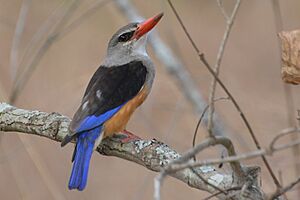Grey-headed kingfisher facts for kids
Quick facts for kids Grey-headed kingfisher |
|
|---|---|
 |
|
| Conservation status | |
| Scientific classification |
The grey-headed kingfisher (Halcyon leucocephala) is a colorful bird found across a huge part of Africa and even in southern Arabia. It lives in many different places, from the Cape Verde Islands in the west to countries like Ethiopia and Somalia in the east, and all the way down to South Africa.
Contents
About the Grey-headed Kingfisher
This kingfisher is known for its pale grey head. Its back is black, but its rump, wings, and tail are a bright blue! Underneath, it has chestnut-colored feathers. Both male and female kingfishers look very similar.
The grey-headed kingfisher has a long, sharp, and bright red beak. It grows to be about 21 centimeters (8.3 inches) long.
Sounds and Calls
When this bird sings, it makes a series of notes that go up and down, becoming louder and more urgent. Its warning call is a quick "tchk, tchk, tchk, tchk."
Where it Lives
The grey-headed kingfisher lives in many tropical and semi-tropical parts of Africa and the Arabian Peninsula. You can find it in countries like Kenya, Tanzania, South Africa, and Saudi Arabia.
It likes to live in woodlands, bushy areas, and even farms. It can be found in places up to about 2,200 meters (7,200 feet) high.
Life and Habits
This kingfisher prefers dry areas like scrublands and woodlands. You might often see it near water, but unlike most kingfishers, it doesn't usually hunt for fish in the water. It prefers to hunt on land!
Hunting for Food
The grey-headed kingfisher often sits very still on a branch for a long time. It watches the ground carefully for insects or small lizards. When it spots something, it bobs its head and then dives down quickly to catch its prey.
Nesting and Family Life
These birds make their nests in holes they dig in steep riverbanks. They are very protective of their nests! If a monitor lizard or another animal comes too close, the kingfisher will aggressively dive-bomb it to scare it away.
Traveling at Night
The grey-headed kingfisher migrates, meaning it travels to different places at certain times of the year. It often flies at night. Sometimes, during these night migrations, they can accidentally fly into tall structures like buildings or power lines.

Images for kids



